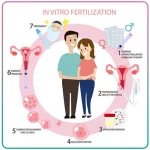What Is FET in IVF? Your Complete Guide to Frozen Embryo Transfer
When you’re exploring the world of in vitro fertilization (IVF), you might stumble across the term “FET” and wonder what it means. Maybe you’ve heard it from a friend, seen it in a fertility forum, or had your doctor mention it casually during a consultation. FET stands for Frozen Embryo Transfer, and it’s a key part of many people’s journey to parenthood. It’s not just a fancy acronym—it’s a process that’s helped countless families grow, and it could be a game-changer for you too.
In this guide, we’ll dive deep into what FET in IVF really is, how it works, why it matters, and what you can expect if you’re considering it. We’ll break it down step-by-step, share the latest insights, and even sprinkle in some practical tips that you won’t find in every article out there. Whether you’re just starting to research fertility options or you’re already knee-deep in the IVF process, this is your one-stop resource for understanding FET.

What Does FET Mean in IVF?
At its core, Frozen Embryo Transfer (FET) is a procedure where an embryo that’s been frozen after an IVF cycle is thawed and placed into the uterus to hopefully grow into a baby. Unlike a “fresh” embryo transfer, where the embryo is transferred right after it’s created, FET uses embryos that have been cryopreserved—meaning they’ve been carefully frozen and stored for later use.
Think of it like this: IVF is like baking a batch of cookies. Sometimes you eat them fresh out of the oven (a fresh transfer), but other times you freeze them to enjoy later (FET). The embryos are created in a lab by combining eggs and sperm, and instead of using them right away, they’re frozen until the time is right for you and your body.
This process has become super popular in recent years, and for good reason—it’s flexible, effective, and backed by some pretty impressive science. In fact, a 2023 study from the American Society for Reproductive Medicine (ASRM) found that FET success rates are often equal to or even higher than fresh transfers in certain cases. Pretty cool, right?
How Does Frozen Embryo Transfer Work?
So, how does FET actually happen? It’s not as complicated as it might sound, but it does involve a few steps to make sure everything goes smoothly. Here’s the rundown:
Step 1: Creating and Freezing the Embryos
First, you go through the early stages of IVF. Your doctor will give you medications to stimulate your ovaries to produce multiple eggs. Those eggs are then retrieved and fertilized with sperm in a lab. After a few days of growing, the healthiest embryos are selected. Some might be transferred fresh, but others are frozen using a technique called vitrification—a super-fast freezing method that prevents ice crystals from forming and damaging the embryo.
Step 2: Preparing Your Body
When you’re ready for FET—whether that’s weeks, months, or even years later—your doctor will prep your uterus. This usually involves hormones like estrogen and progesterone to thicken your uterine lining, making it a cozy home for the embryo. Some people use a natural cycle instead, relying on their body’s own hormones, but most go with the medicated route for better control.
Step 3: Thawing and Transferring
On transfer day, the lab thaws the frozen embryo (don’t worry, they’re pros at this—it survives the process over 95% of the time!). Then, your doctor uses a thin catheter to place the embryo into your uterus. It’s a quick procedure, kind of like a Pap smear, and you’re usually in and out within an hour.
Step 4: The Waiting Game
After the transfer, you wait about 10-14 days to take a pregnancy test. This “two-week wait” can feel like forever, but it’s when the embryo (hopefully) implants and starts growing.
Why Choose FET Over Fresh Transfer?
You might be wondering, “Why freeze embryos at all? Why not just use them fresh?” Great question! There are a bunch of reasons why FET has become a go-to option for so many people.
- Better Timing: With a fresh transfer, your body’s still recovering from the egg retrieval process, which can throw off your hormones. FET lets you wait until your uterus is in tip-top shape, often leading to better outcomes.
- Higher Success Rates: Studies—like one from the journal Fertility and Sterility in 2022—show that FET can have higher implantation rates because the uterine lining isn’t stressed from overstimulation.
- Flexibility: Got extra embryos? You can save them for later, whether that’s for another baby or if the first try doesn’t work out.
- Reduced Risk: FET lowers the chance of ovarian hyperstimulation syndrome (OHSS), a rare but serious IVF complication.
Plus, freezing embryos is like hitting the pause button on your fertility journey. It gives you breathing room to plan, heal, or even deal with life’s curveballs without losing those precious embryos.
What Are the Success Rates for FET?
Success rates are a big deal when you’re thinking about FET, and the good news is they’re pretty encouraging. On average, the chance of a frozen embryo transfer leading to a live birth is around 35-40% per cycle for women under 35, according to the Society for Assisted Reproductive Technology (SART) 2023 data. That number drops as age goes up, but it’s still solid compared to fresh transfers.
Here’s a quick breakdown based on age:
| Age Group | FET Success Rate (Live Birth) |
|---|---|
| Under 35 | 38-42% |
| 35-37 | 33-37% |
| 38-40 | 25-30% |
| Over 40 | 15-20% |
What boosts those odds? Things like embryo quality, your overall health, and how well your uterine lining is prepared. One unique perk of FET is that doctors can test embryos for genetic issues (called PGS or PGT-A) before freezing, which can bump up success rates even more.
The Emotional Side of FET: What No One Talks About
Let’s get real for a second—FET isn’t just about science and stats. It’s an emotional rollercoaster too, and that’s something you won’t always find in the typical fertility pamphlet. Freezing embryos can feel like putting your dreams on ice (literally!), and thawing them later might bring up a mix of hope, fear, and “what ifs.”
For example, Sarah, a 34-year-old mom from Texas, shared her story with me. After two failed fresh transfers, she opted for FET with her last embryo. “I was terrified it wouldn’t survive the thaw,” she said. “But when it worked, it felt like a miracle—like this little fighter was meant to be mine.” Her daughter’s now two, and Sarah swears by FET’s second-chance magic.
On the flip side, the waiting can mess with your head. The two-week wait after transfer is notorious for driving people up the wall—every twinge feels like a sign, and every Google search leads to a rabbit hole. That’s why it’s key to have a support system, whether it’s a partner, friend, or online community.
Quick Coping Checklist
✔️ Journal your feelings to get them out of your head.
✔️ Try light exercise like yoga to ease stress.
❌ Don’t obsess over symptoms—your body’s sneaky like that.
❌ Avoid pregnancy tests too early; they can give false hope.
FET vs. Fresh: A Side-by-Side Look
Still torn between FET and fresh transfer? Let’s stack them up so you can see the differences clearly.
| Feature | Fresh Transfer | Frozen Embryo Transfer |
|---|---|---|
| Timing | Right after egg retrieval | Anytime after freezing |
| Hormone Prep | High doses for retrieval | Lighter doses for lining |
| Success Rate | 30-35% (under 35) | 35-40% (under 35) |
| Flexibility | Limited—tied to cycle | Total control over timing |
| Risk of OHSS | Higher | Lower |
One thing that’s not talked about enough? FET lets you batch your embryos. If you’ve got multiple good ones, you can freeze them all and transfer one at a time, reducing the stress of starting from scratch each cycle.
The Science Behind Freezing Embryos
Ever wonder how embryos survive being frozen? It’s pretty mind-blowing. The vitrification process uses cryoprotectants—think of them as embryo antifreeze—to protect cells from damage. The embryos are cooled to -196°C (-321°F) in liquid nitrogen, where they can stay viable for years. A 2024 report from the European Society of Human Reproduction and Embryology (ESHRE) confirmed that embryos frozen for over a decade can still lead to healthy pregnancies.
Fun fact: The longest-known frozen embryo to result in a live birth was stored for 27 years! That baby was born in 2020, proving just how resilient these tiny bundles can be.
Preparing for Your FET: Tips You’ll Wish You Knew Sooner
Getting ready for FET isn’t just about popping pills—it’s about setting yourself up for success. Here’s how to nail it:
Before the Transfer
- Nutrition Matters: Load up on foods rich in folate, omega-3s, and antioxidants (think leafy greens, salmon, and berries). A 2023 study in Human Reproduction linked better diet quality to higher FET success.
- Sleep Like a Champ: Aim for 7-9 hours a night. Poor sleep can mess with your hormones, and you want them on your side.
- Ask Questions: Don’t be shy—quiz your doctor about thaw survival rates and their FET protocol.
During the Process
- Stay Warm: Some clinics suggest keeping your feet warm post-transfer (socks are your friend!). It’s not proven, but it can’t hurt.
- Hydrate: Water helps your body process those meds and keeps everything flowing.
After the Transfer
- Rest, but Don’t Hibernate: Take it easy for a day or two, but don’t lie flat for weeks—light movement is fine.
- Mind Your Mind: Try meditation apps like Calm or Headspace to keep anxiety in check.
Interactive Quiz: Is FET Right for You?
Not sure if FET fits your plan? Take this quick quiz to find out! Answer yes or no, and tally your “yes” answers.
- Do you want flexibility in when you try for a pregnancy?
- Are you worried about hormone overload from egg retrieval?
- Do you have extra embryos from an IVF cycle?
- Would you like the option to genetically test your embryos?
- Are you okay with a process that might take a bit longer?
- 3+ Yeses: FET could be your sweet spot—talk to your doctor!
- 1-2 Yeses: It’s worth considering, but weigh it against a fresh transfer.
- 0 Yeses: Fresh might be more your speed for now.

Common FET Myths Debunked
There’s a lot of chatter out there about FET, and not all of it’s true. Let’s clear up some big ones:
- Myth: Frozen embryos aren’t as good as fresh ones.
Truth: Nope! Studies show frozen embryos often do just as well, if not better, thanks to improved freezing tech. - Myth: FET is way more expensive.
Truth: It can actually save money long-term since you don’t need repeat egg retrievals. - Myth: The thaw process ruins most embryos.
Truth: Over 95% survive thawing with modern methods.
What’s New in FET Research?
Fertility science moves fast, and FET’s no exception. Here’s what’s hot in 2025:
- AI-Powered Embryo Selection: Clinics are using artificial intelligence to pick the best embryos for freezing, boosting success rates by up to 10%, per a 2024 Nature Medicine study.
- Personalized Protocols: Doctors are tailoring hormone doses based on your DNA, which could make prep smoother and more effective.
- Long-Term Storage Data: New research shows kids born from embryos frozen for 15+ years are just as healthy as those from fresh cycles—reassuring news if you’re planning a long gap.
One area that’s under-discussed? The role of the microbiome. Early studies suggest a balanced uterine microbiome might improve implantation rates during FET. While it’s not standard practice yet, some clinics are exploring probiotics as a prep step—something to watch!
FET Costs: Breaking It Down
Money’s a big piece of the puzzle, so let’s talk numbers. FET is often cheaper than a full IVF cycle since you skip egg retrieval, but costs still add up. Here’s a rough guide based on U.S. averages in 2025:
- Thawing and Transfer: $3,000-$5,000
- Medications: $500-$1,500
- Storage Fees: $300-$600 per year
- Total per FET Cycle: $4,000-$7,000
Compare that to a full IVF cycle ($12,000-$15,000), and FET looks like a bargain—especially if you’ve already got embryos banked. Some insurance plans cover it, so check yours!
Real Stories: FET Wins and Challenges
Hearing from people who’ve been there can make FET feel less abstract. Take Mia, a 39-year-old from California. After a miscarriage with a fresh transfer, she switched to FET. “I loved that I could take a break and come back stronger,” she said. Her son was born in 2024 after a textbook FET cycle.
Then there’s James and Lisa, a couple who froze embryos before Lisa’s cancer treatment. Five years later, their FET brought twins. “It was like a gift we’d given our future selves,” James told me.
Not every story’s a win, though. Some face failed thaws or negative tests, and that’s tough. But the option to try again with frozen embryos keeps hope alive.
Your FET Action Plan: Next Steps
Ready to explore FET? Here’s how to get started:
- Chat with Your Clinic: Ask about their FET success rates and process.
- Check Your Embryos: If you’ve done IVF, find out how many are frozen and their quality.
- Plan Your Timing: Decide when you’re physically and emotionally ready.
- Budget It Out: Get a cost estimate and look into financing or insurance.
- Build Your Team: Line up support—friends, a counselor, or a fertility coach.
Poll: What’s Your FET Curiosity?
We want to hear from you! Pick one:
- A) I’m most curious about success rates.
- B) I want to know more about the emotional side.
- C) Costs are my big question.
Drop your answer in the comments—it’ll help us tailor future posts!
The Future of FET: What’s Next?
FET’s already amazing, but it’s only getting better. Imagine a world where you can freeze embryos indefinitely with zero quality loss, or where smart tech predicts your perfect transfer day. That’s not sci-fi—it’s where research is heading. For now, FET’s a reliable, powerful tool that’s making parenthood possible for more people every day.
So, what is FET in IVF? It’s hope, science, and a little bit of magic rolled into one. It’s a chance to build your family on your terms, with a process that’s safer, smarter, and more successful than ever. If you’re on this path, know you’re not alone—and FET might just be the key to your happy ending.


